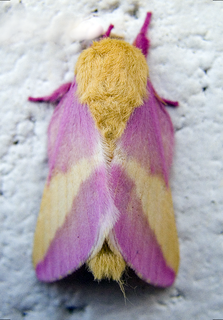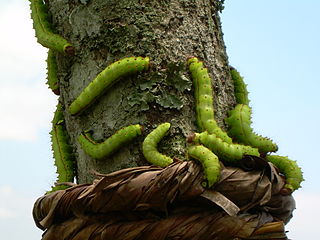
Bombyx mori, the domestic silk moth, is an insect from the moth family Bombycidae. It is the closest relative of Bombyx mandarina, the wild silk moth. The silkworm is the larva or caterpillar of a silk moth. It is an economically important insect, being a primary producer of silk. A silkworm's preferred food are white mulberry leaves, though they may eat other mulberry species and even the osage orange. Domestic silk moths are entirely dependent on humans for reproduction, as a result of millennia of selective breeding. Wild silk moths are not as commercially viable in the production of silk.

Attacus atlas, the Atlas moth, is a large saturniid moth endemic to the forests of Asia. The species was first described by Carl Linnaeus in his 1758 10th edition of Systema Naturae.

The yellow-tail, goldtail moth or swan moth is a moth of the family Erebidae. The species was first described by Johann Kaspar Füssli in 1775, and has commonly been placed within the related genus Euproctis. It is distributed throughout Europe to the Urals, then east across the Palearctic to Siberia and south to India and Sri Lanka.
Bombyx is the genus of true silk moths or mulberry silk moths of the family Bombycidae, also known as silkworms, which are the larvae or caterpillars of silk moths. The genus was erected as a subgenus by Carl Linnaeus in his 10th edition of Systema Naturae (1758).

Dryocampa rubicunda, the rosy maple moth, is a small North American moth in the family Saturniidae, also known as the great silk moths. It was first described by Johan Christian Fabricius in 1793. The species is known for its wooly body and pink and yellow coloration, which varies from cream or white to bright pink or yellow. Males have bushier antennae than females, which allow them to sense female pheromones for mating.

Actias selene, the Indian moon moth or Indian luna moth, is a species of saturniid moth from Asia. It was first described by Jacob Hübner in 1807. This species is popular among amateur entomologists and is often reared from eggs or cocoons that are available from commercial sources. They fly mainly at night.

Orgyia antiqua, the rusty tussock moth or vapourer, is a moth in the family Erebidae.

The saddleback caterpillar is the larva of a species of moth native to eastern North America. It is also found in Mexico. The species belongs to the family of slug caterpillars, Limacodidae.

Ornithoptera priamus, the common green birdwing, Cape York birdwing, Priam's birdwing, northern birdwing or New Guinea birdwing is a widespread species of birdwing butterfly found in the central and south Moluccas, New Guinea, Bismarck Archipelago, Solomon Islands, and north-east Australia.

Bombyx mandarina, the wild silk moth, is an insect from the moth family Bombycidae. It is the closest relative of Bombyx mori, the domesticated silk moth. The silkworm is the larva or caterpillar of a silk moth. Unlike the domesticated relative which is unable to fly or indeed persist outside human care, the wild silk moth is a fairly ordinary lepidopteran. Its main difference from the domesticated taxon is the more slender body with well-developed wings in males, and the dull greyish-brown colour.

Actias isis is a moth of the family Saturniidae first described by Léon Sonthonnax in 1899.

China is the world's largest and earliest silk producer. The vast majority of Chinese silk originates from the mulberry silkworms. During the larval stage of its life-cycle, the insects feed on the leaves of mulberry trees. Non-mulberry silkworms cocoon production in China primarily focuses on wild silk from the Chinese Tussah moth. This moth typically feeds on trees and its larvae spin coarser, flatter, yellower filament than the mulberry silk moths.

Cydia nigricana, the pea moth, is a moth of the family Tortricidae. It is found in Europe.

Wild silks have been known and used in many countries from early times, although the scale of production is far smaller than that from cultivated silkworms. Silk cocoons and nests often resemble paper or cloth, and their use has arisen independently in many societies.

Cricula trifenestrata, the cricula silkmoth, is a species of wild silk moth of the family Saturniidae. It is found from India to the Philippines, Sulawesi, Java, and Sri Lanka.

Bombycomorpha bifascia, the pepper-tree caterpillar, is a moth of the family Lasiocampidae, which is native to southern Africa.
Gastridiota is a monotypic genus consisting solely of Gastridiota adoxima, a moth of the family Bombycidae. The genus was erected by Alfred Jefferis Turner in 1922 but the species had been described by him in 1902 as Andraca adoxima. It is found in the subtropical east of Australia, from the Bunya Mountains and Montville in southern Queensland to north-eastern New South Wales.

Antheraea pernyi, the Chinese (oak) tussar moth, Chinese tasar moth or temperate tussar moth, is a large moth in the family Saturniidae. The species was first described by Félix Édouard Guérin-Méneville in 1855. Antheraea roylei is an extremely close relative, and the present species might actually have evolved from ancestral A. roylei by chromosome rearrangement.

Troides amphrysus, the Malay birdwing, is a birdwing butterfly in the genus Troides in the family Papilionidae.

Antheraea paphia, known as the South India small tussore, the tasar silkworm and vanya silkworm is a species of moth of the family Saturniidae found in India and Sri Lanka. The bulk of the literature on this species uses a junior synonym, Antheraea mylitta, rather than the correct name, A. paphia. It is one of a number of tasar silkworms, species that produce Tussar silk, a kind of wild silk that is made from the products of saturniid silkworms instead of the domesticated silkworm.




















